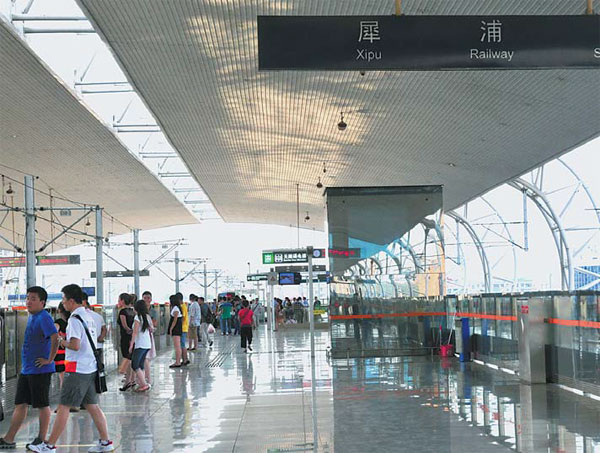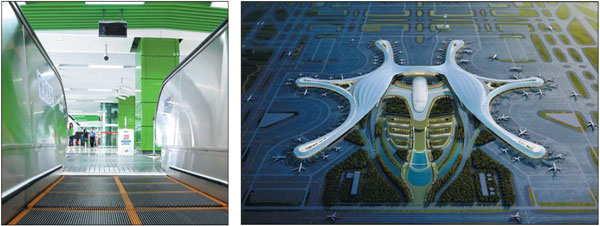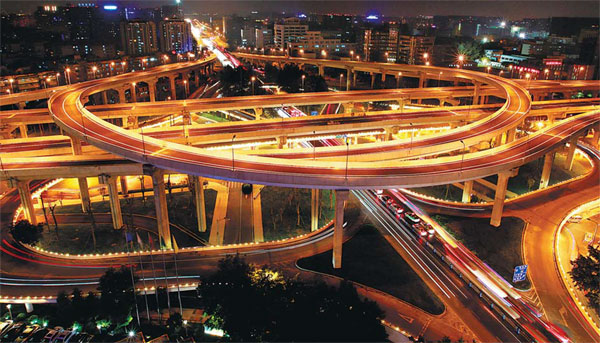Transport network opens Chengdu to the world
City prioritizes efficient local and international transit systems, Peng Chao reports.
Chengdu, an exceptional large city in Southwest China, covers an area of 12,390 square kilometers, has a population of more than 14 million and was the first city in west China to have a subway system.
It also has the largest number of private cars and international air-routes in west China, and the fastest and most frequently used direct freight train from China to Europe.
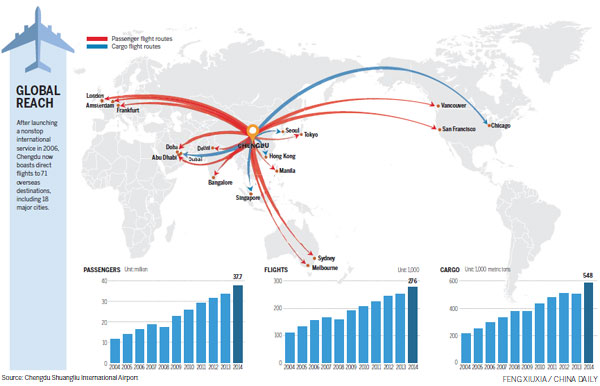
|
Passengers use one of Chengdu's modern subway stations. Photos Provided to China Daily |
|
Left: A station on Metro Line 2, which links Chengdu's central urban areas to Longquanyi district and Pixian county. Right: An artist's impression of the second airport in Chengdu. |
|
The busy Second Ring Road in Chengdu. The city already has four ring roads and one ring expressway. |
"It's easier to reach heaven than to take the roads in Sichuan" is a line from a famous poem written during the Tang Dynasty (AD618-907).
That situation has changed totally today. With the booming of its economy and its opening up to the outside world during the past years, Chengdu has emerged as an important transportation hub.
"I think the biggest change of Chengdu during my stay here is the transportation," said Jonathan Kott from Seattle, who has lived in the city for 17 years.
Kott was first lured to the city by its delicious food, and fell in love with the location at first sight.
He speaks the Chengdu dialect fluently and is known to many locals as he often hosts local TV programs.
Kott said when he first arrived in Chengdu, the second ring road was mostly complete.
"Now Chengdu has wide roads, a growing subway system and an extensive bus system. These improvements greatly enhance Chengdu's transportation efficiency," he said.
"Furthermore, the newly opened international flights also add convenience and save time flying to other Asian and European cities. I think more foreigners will choose Chengdu as a travel destination and as a hub for other travel within Asia," he added.
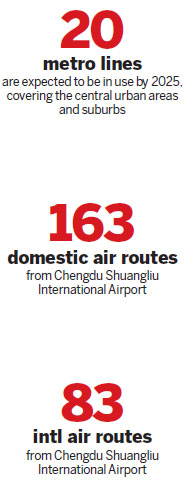
Its economic prosperity has enabled Chengdu residents to own the third-largest number of private cars in a city in China.
To provide its residents with an efficient and convenient public transportation service, the city government decided to build a comprehensive public transportation system with metro lines as its backbone.
Chengdu started the operation of its first metro line in September 2010, making it the first city in west China to provide subway services.
Metro Line 1 stretches from the north of the city to the south, connecting the central urban areas to the emerging Chengdu High-Tech Zone and Tianfu New Area.
The Chengdu High-Tech Zone is one of the country's earliest and is home to hundreds of high-tech companies. Last year, it ranked third among national high-tech zones for innovation, according to the Ministry of Science and Technology. It was recently upgraded to a State-level innovation demonstration area, again the first of its kind in west China.
Tianfu New Area, approved by the State Council in October 2014, is the country's 11th national-level development area. It stretches from the southern part of Chengdu to the neighboring cities.
The new development area covers 1,578 sq k, 82 percent of which is in Chengdu. It encompasses six key industries - information technology, vehicle production, clean energy, new materials, bio-pharmaceuticals and finance.
The east-west Metro Line 2, which started operation in September 2012, connects the central urban areas to Longquanyi district, one of the country's major automobile industry bases, and Pixian county, which is famous for its food and cultural industry and is home to many universities and technology companies.
Another 18 metro lines are expected to go into operation by 2025, covering the central urban areas and the suburbs, according to the city plans. By then, 45 percent of residents are expected to choose the subway as their preferred method of travel.
The city also plans to construct three streetcar lines with a total length of 65 kilometers, two of which are expected to start construction this year and go into operation in 2017.
The bus system has also been upgraded. More bus routes have been designed according to residents' needs and more buses, especially new-energy vehicles, have been put into use.
Most of the city's bus stops are equipped with electronic boards that show the location of the buses.
To ease traffic pressure in the downtown area, Chengdu started its Second Ring Road Reconstruction Project in 2012 and built a bus rapid transit system.
The BRT system started operation in May 2013 and buses on it run two times faster than previously.
Chengdu already has four ring roads and one ring expressway. A second ring expressway is expected to open to traffic this year and construction of a third ring expressway is due to start by the end of the year.
The second ring expressway stretches 223 km and connects 12 county-level administrative regions, while the third ring expressway would cover 459 km and connect Chengdu to the nearby cities.
Transportation hub
To boost communication with the outside world and become an international metropolis, Chengdu has placed great importance on developing its transportation system.
Large numbers of international air routes have been launched in recent years, connecting Chengdu to cities including London, San Francisco, Moscow, Melbourne and Abu Dhabi.
Chengdu Shuangliu International Airport is now the fourth-busiest airport on the Chinese mainland. It operates 163 domestic and 83 international routes.
The city is scheduled to build a new airport 51 km southeast of downtown Chengdu that will be larger than the present airport. This will make Chengdu the third city on the Chinese mainland to have a second civil airport, after Beijing and Shanghai.
According to the plans, the first phase of the new airport will finish by 2018, with annual capacity to handle 40 million passengers and 700,000 metric tons of cargo. The long-term goal is to handle 90 million passengers and 2 million tons of cargo annually.
Pan Gangjun, general manager of the Sichuan Province Airport Group, said the new airport would mainly serve international routes, while Shuangliu airport would handle domestic flights.
"Located at the core of southwestern China, the new airport could develop into the largest on the Silk Road Economic Belt and in the Yangtze River Economic Zone, acting as China's gateway to Europe, South Asia, Southeast Asia, Central Asia and the Middle East," he said.
The city also boasts an advanced rail transport system. Railways lines starting from Chengdu not only connect to cities all over China, but also to Central Asia and Europe.
The Chengdu-Europe Express Rail, which opened in April 2013, starts from Chengdu and ends in Lodz, Poland.
It is the fastest and most frequently used direct freight service from China to Europe, according to Chen Zhongwei, director of the Chengdu Logistics Office.
"The express train is a month faster than ocean shipping and costs only a quarter of air cargo transportation," Chen said.
The railway operated its first return route service last month. The train arrived in Chengdu on September 6, bringing back 41 carriages of food and beverages including wine, beer, dairy products and biscuits from Europe.
With an increasing number of Chinese cities linked to its express rail, Chengdu is becoming a key land transport hub for Asia and Europe.
Zeng Yani contributed to the story.
Contact the writer at pengchao@chinadaily.com.cn
(China Daily 09/15/2015 page7)


